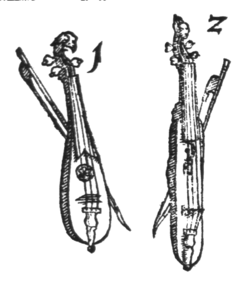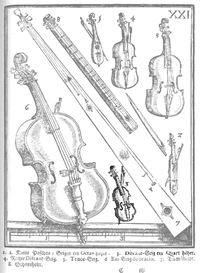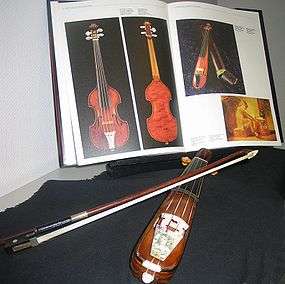Kit violin
 | |
| Other names | kytte, treble violin; creytertjes; poche, pochette, pochette d’amour, sourdine; Posch, Tanzmeistergeige, Taschengeige, Trögl-geige; canino, pochetto, sordina, sordino; linterculus[1] |
|---|---|
| Classification | |
| Related instruments | |
The kit violin, dancing master's kit, or kit, is a stringed instrument. It is essentially a very small violin, designed to fit in a pocket – hence its other common name, the pochette (French for small pocket). It was used by dance masters in royal courts and other places of nobility, as well as by street musicians until around the 18th century. Occasionally, the rebec was used in the same way. Several are called for (as violini piccoli alla francese – small French violins) in Monteverdi's 1607 Orfeo.[2]
History
The word "kit" probably arose from an abbreviation of the word "pocket" to "-cket" and subsequently "kit"; alternatively, it may be a corruption of “cittern” (Greek: κιθάρα).[3] Trichet is said to have described the leather carrying case of the kit as a poche, hence, "The Pocket Violin". Similarly, Mersenne wrote that it was common practice among the kit violin's players (such as traveling minstrels or dance teachers) to carry the violin in a pocket. The term "kit" is believed to first have been used in the first quarter of the 16th century, in England where it was mentioned in Interlude of the Four Elements, c. 1517.
The instrument's body is very small, but its fingerboard is made long relative to the instrument's overall size in order to preserve as much of the instrument's melodic range as possible.
Many violinists in the eighteenth century used kits because of their portability. The pochette or pocket fiddle was used by dance masters not during the actual dances, although they could be used, but were used when teaching dance to students. Niel Gow is known to have played a kit, and reportedly carried one in his pocket each time he walked from his house in Inver to Blair Castle, where he worked. Thomas Jefferson also owned at least two kits.
A common misconception is that kits were used for children. In fact, they were made for adults—their small size is so that they could be used in situations where a full-sized violin was too large to carry, or too expensive to own. The "pocket fiddle" or "pochette" should not be confused with a saddle fiddle, the latter being a proper fiddle or violin with a nearly full-sized finger board, and a violin body that is the same shape as a full-sized version.
Gallery
 Rebec + Pochette |
 Kit violin and other violins |
 Kit violin |
References
- ↑ Mary Remnant. "Kit". In L. Root, Deane. Grove Music Online. Oxford Music Online. Oxford University Press. (subscription required)
- ↑ The Ultimate Encyclopaedia of Musical Instruments, ISBN 1-85868-185-5, p85
- ↑
 Chisholm, Hugh, ed. (1911). "Kit". Encyclopædia Britannica (11th ed.). Cambridge University Press.
Chisholm, Hugh, ed. (1911). "Kit". Encyclopædia Britannica (11th ed.). Cambridge University Press.
